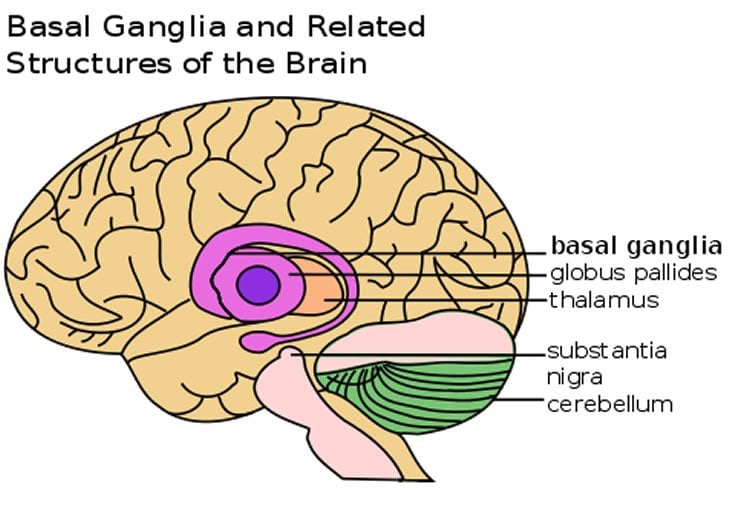Dopamine transmission mediated by D1 receptors is essential for information flow through the basal ganglia to control movements.
Dopamine deficiency in the basal ganglia (a set of subcortical structures) causes severe motor dysfunctions, such as slowness of movements (bradykinesia), as observed in Parkinson’s disease. Dopamine binds D1 and D2 receptors that are expressed in the nerve cells of the striatum (a structure of the basal ganglia), and exerts different effects on the nerve cells. However, how dopamine controls through these receptors the information flow in the basal ganglia and voluntary movements is still not clear.
Assistant Professor Satomi Chiken and Professor Atsushi Nambu from National Institute for Physiological Sciences, Dr. Asako Sato from Kitasato University, Professor Toshikuni Sasaoka from Niigata University, and their research team members have revealed that lack of dopamine transmission through D1 receptors disturbs information flow through the “direct pathway” in the basal ganglia, and ends up in difficulty in initiating voluntary movements. This study was supported by JSPS KAKENHI and CREST, and published online in the Oxford journal Cerebral Cortex on October 7, 2015.
The research team successfully developed a novel transgenic mouse model in which dopamine D1 receptors can be reversibly reduced by a pharmacological agent “doxycycline”, and found that the mice showed decreased movements when D1 receptors were reduced. The team used electrophysiological techniques in awake mice and examined the electrical activity of the nerve cells in the entopeduncular nucleus (EPN, the homologous structure to the internal segment of the globus pallidus in humans) that is the output station of the basal ganglia. Normally, the electrical stimulation of the motor cortex, which resembles the electrical activity during voluntary movements, causes triphasic response consisting of early excitation, inhibition and late excitation in the nerve cells of the EPN, and the “inhibition” is mediated by the “direct pathway” and acts to initiate movements. When D1 receptors were reduced in the transgenic mice by “doxycycline”, the triphasic response was changed, and the “inhibition” was largely decreased. These results suggest that dopamine transmission mediated by D1 receptors is essential for information flow through the “direct pathway” to appropriately initiate movements. The research team also revealed that spontaneous activity of nerve cells in the ENP did not change when D1 receptors were reduced, which denies the prevalent view that lack of D1 receptor-mediated dopamine transmission increases spontaneous nerve cell activity in the EPN. The results suggest that transient activity changes through the “direct pathway”, not spontaneous activity changes, in the EPN are responsible for slowness of movements in Parkinson’s disease.

“We have shown that lack of dopamine transmission via D1 receptors disrupts information flow through the ‘direct pathway’ and results in slowness of movements in Parkinson’s disease. This finding provides us important clues to develop new therapies to the disease, such as on-demand activation of D1 receptors to facilitate the information flow through the ‘direct pathway'”, Professor Nambu said.
Source: Atsushi Nambu – National Institutes of Natural Sciences
Image Source: The image is credited to John Henkel/FDA and is in the public domain
Original Research: Abstract for “Dopamine D1 Receptor-Mediated Transmission Maintains Information Flow Through the Cortico-Striato-Entopeduncular Direct Pathway to Release Movements” by Chiken, S., Sato, A., Ohta, C., Kurokawa, M., Arai, S., Maeshima, J., Sunayama-Morita, T., Sasaoka, T., and Nambu, A. in Cerebral Cortex. Published online October 6 2015 doi:10.1093/cercor/bhv209
Abstract
Dopamine D1 Receptor-Mediated Transmission Maintains Information Flow Through the Cortico-Striato-Entopeduncular Direct Pathway to Release Movements
In the basal ganglia (BG), dopamine plays a pivotal role in motor control, and dopamine deficiency results in severe motor dysfunctions as seen in Parkinson’s disease. According to the well-accepted model of the BG, dopamine activates striatal direct pathway neurons that directly project to the output nuclei of the BG through D1 receptors (D1Rs), whereas dopamine inhibits striatal indirect pathway neurons that project to the external pallidum (GPe) through D2 receptors. To clarify the exact role of dopaminergic transmission via D1Rs in vivo, we developed novel D1R knockdown mice in which D1Rs can be conditionally and reversibly regulated. Suppression of D1R expression by doxycycline treatment decreased spontaneous motor activity and impaired motor ability in the mice. Neuronal activity in the entopeduncular nucleus (EPN), one of the output nuclei of the rodent BG, was recorded in awake conditions to examine the mechanism of motor deficits. Cortically evoked inhibition in the EPN mediated by the cortico-striato-EPN direct pathway was mostly lost during suppression of D1R expression, whereas spontaneous firing rates and patterns remained unchanged. On the other hand, GPe activity changed little. These results suggest that D1R-mediated dopaminergic transmission maintains the information flow through the direct pathway to appropriately release motor actions.
“Dopamine D1 Receptor-Mediated Transmission Maintains Information Flow Through the Cortico-Striato-Entopeduncular Direct Pathway to Release Movements” by Chiken, S., Sato, A., Ohta, C., Kurokawa, M., Arai, S., Maeshima, J., Sunayama-Morita, T., Sasaoka, T., and Nambu, A. in Cerebral Cortex. Published online October 6 2015 doi:10.1093/cercor/bhv209






